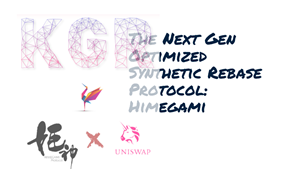
Himegami is Revolutionizing the Cryptocurrency Market with a Decentralized Elastic Supply Model
/EIN News/ -- Harju County, Estonia, March 02, 2021 (GLOBE NEWSWIRE) -- As the cryptocurrency market continues to mature, crypto projects also continue to evolve further driving the evolution of the market. So far, we have seen cryptocurrency projects with a fixed supply for the native tokens. The ultimate aim here has been to create scarcity and drive crypto prices higher.
Now, we believe it’s time for creating elastic supply of decentralized digital currencies. KGR is one such dynamic and completely decentralized elastic supply protocol that aims to cater to the liquidity needs of the broader crypto market, and more importantly, to solve the issues of market manipulation.
The KRG cryptocurrency achieves better balance of supply and demand as it correlates a synthetic asset’s price perfectly with the price of its underlying asset. The KGR token is basically an elastic cryptocurrency with its target price at 1 Japanse Yen adjusted for inflation.
The price of KGR can be higher or lower than 1 Yen, however, the supply is always adjusted to meet the target of 1 Japanese yen (¥). If high demand drives the price higher above 1 Yen, the Himegami protocol will add more supply creating a selling pressure and a ‘rebase’ action. To distribute the KGR token to the token holders, the system would be able to issue 100,000 tokens per rebase then sell it on public exchanges following a first-come-first-serve rule. The unsold tokens in the day will be burned. This method was implemented in smart contracts. This makes KGR one-of-its-kind cryptocurrency with such flexibility and supply elasticity.
The Himegami rebase system is implemented every 1385 minutesto rebase the supply. The rebase function is a new concept to the crypto market and is basically associated to supply smoothening for decentralized elastic supply tokens like KGR.
Since the KGR tokens expand and contract based on the demand and supply, the rebase mechanism ensures that the percentage holding for users remains the same.
We envision the Himegami protocol to be a hedge asset for all of the crypto world as well as to the emerging sector of Decentralized Finance (DeFi). The stability of KGR can help DeFi investors to reduce their dependency on some of the centralized stablecoins. It can work as a hedge asset, a DeFi collateral, and a stable medium of exchange for the entire crypto space.
We are positioning KGR as a useful crypto token and a collateral asset for Decentralized Finance (DeFi). Its unique qualities like decentralized, profitable, self-governing, and more stable asset, makes it important to DeFi. In the future, KGR may have multiple different applications and can be used to supplement other DeFi projects like Tezos, Polkadot, Cardano, and others.
Furthermore, the programmatic rebasing protocol aims to solve the issue of massive fluctuations in liquidity and volatility by making it more predictable and rewarding for everyone involved.
This allows us to position Himegami not only in the current crypto ecosystem but create a whole new host of applications for it in the private DeFi ecosystems of tomorrow that many haven’t even been thought about yet.
Himegami Protocol Founder Leo Bai
Media contact:
Company: Himegami
Name: Leo Bai-Founder
Email: info@himegamiprotocol.org
Website: http://himegamiprotocol.org/
Attachment
EIN Presswire does not exercise editorial control over third-party content provided, uploaded, published, or distributed by users of EIN Presswire. We are a distributor, not a publisher, of 3rd party content. Such content may contain the views, opinions, statements, offers, and other material of the respective users, suppliers, participants, or authors.



